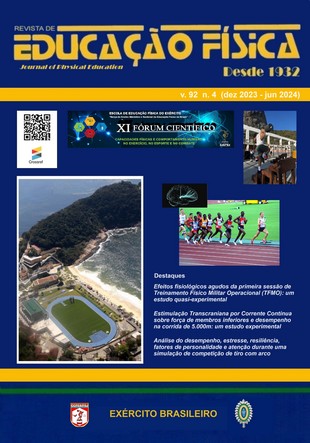Abstract
Introduction: Transcranial direct current stimulation (tDCS) in brain function is described as influencing the individual's cortical excitability, inducing positive changes in cognitive and motor areas. Thus, tDCS could be identified as an ergogenic resource in the sports environment, in the search for better results.
Objective: To explore the acute effect of tDCS applied to 5,000m runners.
Methods: Experimental study, controlled by Sham (placebo effect), blinded, in male 5,000m runners, aged 18 to 32 years. Eighteen athletes were randomized into the Anodal (n=9, 29±7 years, 63±8 kg) and Sham (n=9, 25±4 years, 67±12 kg) groups. Total running time (t) and peak torque (Pt) were evaluated before and after stimulation.
Results: The running time and speed of the Anodal group was lower compared to the Sham group (p=0.02; 95%CI 0.11–2.32; d=1.24) and (p=0.02, 95%CI 0.05–2.20; d=1.15), respectively. However, no difference was found in Pt (p=0.70).
Conclusion: The findings indicated that tDCS can contribute to acutely optimize the time/speed of 5,000m runners.
References
. Angius L, Mauger AR, Hopker J, Pascual-Leone A, Santarnecchi E, Marcora SM. Bilateral extracephalic transcranial direct current stimulation improves endurance performance in healthy individuals. Brain Stimulation. 2018;11(1): 108–117. https://doi.org/10.1016/j.brs.2017.09.017.
Ardolino G, Bossi B, Barbieri S, Priori A. Non-synaptic mechanisms underlie the after-effects of cathodal transcutaneous direct current stimulation of the human brain. The Journal of Physiology. 2005;568(Pt 2): 653–663. https://doi.org/10.1113/jphysiol.2005.088310.
Nitsche MA, Paulus W. Sustained excitability elevations induced by transcranial DC motor cortex stimulation in humans. Neurology. 2001;57(10): 1899–1901. https://doi.org/10.1212/WNL.57.10.1899.
Stagg CJ, Antal A, Nitsche MA. Physiology of Transcranial Direct Current Stimulation. The journal of ECT. 2018;34(3): 144–152. https://doi.org/10.1097/YCT.0000000000000510.
Santarnecchi E, Brem AK, Levenbaum E, Thompson T, Kadosh RC, Pascual-Leone A. Enhancing cognition using transcranial electrical stimulation. Current Opinion in Behavioral Sciences. 2015;4: 171–178. https://doi.org/10.1016/j.cobeha.2015.06.003.
Colzato LS, Nitsche MA, Kibele A. Noninvasive Brain Stimulation and Neural Entrainment Enhance Athletic Performance—a Review. Journal of Cognitive Enhancement. 2017;1(1): 73–79. https://doi.org/10.1007/s41465-016-0003-2.
Vitor-Costa M, Pereira LA, Montenegro RA, Okano AH, Altimari LR. A estimulação transcraniana por corrente contínua como recurso ergogênico: uma nova perspectiva no meio esportivo. Revista da Educação Física / UEM. 2012;23: 167–174. https://doi.org/10.4025/reveducfis.v23i2.10670.
Lefaucheur JP, Antal A, Ayache SS, Benninger DH, Brunelin J, Cogiamanian F, et al. Evidence-based guidelines on the therapeutic use of transcranial direct current stimulation (tDCS). Clinical Neurophysiology. 2017;128(1): 56–92. https://doi.org/10.1016/j.clinph.2016.10.087.
Lattari E, Campos C, Lamego MK, Legey S, Neto GM, Rocha NB, et al. Can Transcranial Direct Current Stimulation Improve Muscle Power in Individuals With Advanced Weight-Training Experience? Journal of Strength and Conditioning Research. 2020;34(1): 97–103. https://doi.org/10.1519/JSC.0000000000001956.
Abdelmoula A, Baudry S, Duchateau J. Anodal transcranial direct current stimulation enhances time to task failure of a submaximal contraction of elbow flexors without changing corticospinal excitability. Neuroscience. 2016;322: 94–103. https://doi.org/10.1016/j.neuroscience.2016.02.025.
Uehara L, Boari Coelho D, Leal-Junior ECP, Vicente de Paiva PR, Batista AF, Duarte Moreira RJ, et al. Effects of Transcranial Direct Current Stimulation on Muscle Fatigue in Recreational Runners: Randomized, Sham-Controlled, Triple-Blind, Crossover Study—Protocol Study. American Journal of Physical Medicine & Rehabilitation. 2022;101(3): 279. https://doi.org/10.1097/PHM.0000000000001721.
Mesquita PHC, Lage GM, Franchini E, Romano-Silva MA, Albuquerque MR. Bi-hemispheric anodal transcranial direct current stimulation worsens taekwondo-related performance. Human Movement Science. 2019;66: 578–586. https://doi.org/10.1016/j.humov.2019.06.003.
Romero-Arenas S, Calderón-Nadal G, Alix-Fages C, Jerez-Martínez A, Colomer-Poveda D, Márquez G. Transcranial Direct Current Stimulation Does Not Improve Countermovement Jump Performance in Young Healthy Men. Journal of Strength and Conditioning Research. 2021;35(10): 2918–2921. https://doi.org/10.1519/JSC.0000000000003242.
Adams GR, Harris RT, Woodard D, Dudley GA. Mapping of electrical muscle stimulation using MRI. Journal of Applied Physiology. 1993;74(2): 532–537. https://doi.org/10.1152/jappl.1993.74.2.532.
Vitor-Costa M, Okuno NM, Bortolotti H, Bertollo M, Boggio PS, Fregni F, et al. Improving Cycling Performance: Transcranial Direct Current Stimulation Increases Time to Exhaustion in Cycling. PloS One. 2015;10(12): e0144916. https://doi.org/10.1371/journal.pone.0144916.
Kamali AM, Kazemiha M, Keshtkarhesamabadi B, Daneshvari M, Zarifkar A, Chakrabarti P, et al. Simultaneous transcranial and transcutaneous spinal direct current stimulation to enhance athletic performance outcome in experienced boxers. Scientific Reports. 2021;11(1): 19722. https://doi.org/10.1038/s41598-021-99285-x.
Klem GH, Lüders HO, Jasper HH, Elger C. The ten-twenty electrode system of the International Federation. The International Federation of Clinical Neurophysiology. Electroencephalography and Clinical Neurophysiology. Supplement. 1999;52: 3–6.
Li LM, Uehara K, Hanakawa T. The contribution of interindividual factors to variability of response in transcranial direct current stimulation studies. Frontiers in Cellular Neuroscience. 2015;9: 181. https://doi.org/10.3389/fncel.2015.00181.
Park I, Kim Y, Kim SK. Athlete-Specific Neural Strategies under Pressure: A fNIRS Pilot Study. International Journal of Environmental Research and Public Health. 2020;17(22): 8464. https://doi.org/10.3390/ijerph17228464.
Baldari C, Buzzachera CF, Vitor-Costa M, Gabardo JM, Bernardes AG, Altimari LR, et al. Effects of Transcranial Direct Current Stimulation on Psychophysiological Responses to Maximal Incremental Exercise Test in Recreational Endurance Runners. Frontiers in Psychology. 2018;9: 1867. https://doi.org/10.3389/fpsyg.2018.01867.

This work is licensed under a Creative Commons Attribution 4.0 International License.
Copyright (c) 2024 Journal of Physical Education
